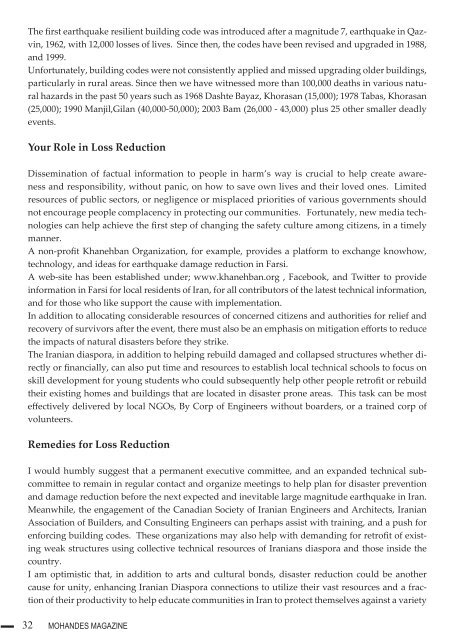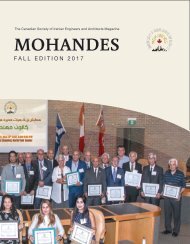Mohandes Magazine Fall-Winter Edition 2018
Create successful ePaper yourself
Turn your PDF publications into a flip-book with our unique Google optimized e-Paper software.
The first earthquake resilient building code was introduced after a magnitude 7, earthquake in Qazvin,<br />
1962, with 12,000 losses of lives. Since then, the codes have been revised and upgraded in 1988,<br />
and 1999.<br />
Unfortunately, building codes were not consistently applied and missed upgrading older buildings,<br />
particularly in rural areas. Since then we have witnessed more than 100,000 deaths in various natural<br />
hazards in the past 50 years such as 1968 Dashte Bayaz, Khorasan (15,000); 1978 Tabas, Khorasan<br />
(25,000); 1990 Manjil,Gilan (40,000-50,000); 2003 Bam (26,000 - 43,000) plus 25 other smaller deadly<br />
events.<br />
Your Role in Loss Reduction<br />
Dissemination of factual information to people in harm’s way is crucial to help create awareness<br />
and responsibility, without panic, on how to save own lives and their loved ones. Limited<br />
resources of public sectors, or negligence or misplaced priorities of various governments should<br />
not encourage people complacency in protecting our communities. Fortunately, new media technologies<br />
can help achieve the first step of changing the safety culture among citizens, in a timely<br />
manner.<br />
A non-profit Khanehban Organization, for example, provides a platform to exchange knowhow,<br />
technology, and ideas for earthquake damage reduction in Farsi.<br />
A web-site has been established under; www.khanehban.org , Facebook, and Twitter to provide<br />
information in Farsi for local residents of Iran, for all contributors of the latest technical information,<br />
and for those who like support the cause with implementation.<br />
In addition to allocating considerable resources of concerned citizens and authorities for relief and<br />
recovery of survivors after the event, there must also be an emphasis on mitigation efforts to reduce<br />
the impacts of natural disasters before they strike.<br />
The Iranian diaspora, in addition to helping rebuild damaged and collapsed structures whether directly<br />
or financially, can also put time and resources to establish local technical schools to focus on<br />
skill development for young students who could subsequently help other people retrofit or rebuild<br />
their existing homes and buildings that are located in disaster prone areas. This task can be most<br />
effectively delivered by local NGOs, By Corp of Engineers without boarders, or a trained corp of<br />
volunteers.<br />
Remedies for Loss Reduction<br />
I would humbly suggest that a permanent executive committee, and an expanded technical subcommittee<br />
to remain in regular contact and organize meetings to help plan for disaster prevention<br />
and damage reduction before the next expected and inevitable large magnitude earthquake in Iran.<br />
Meanwhile, the engagement of the Canadian Society of Iranian Engineers and Architects, Iranian<br />
Association of Builders, and Consulting Engineers can perhaps assist with training, and a push for<br />
enforcing building codes. These organizations may also help with demanding for retrofit of existing<br />
weak structures using collective technical resources of Iranians diaspora and those inside the<br />
country.<br />
I am optimistic that, in addition to arts and cultural bonds, disaster reduction could be another<br />
cause for unity, enhancing Iranian Diaspora connections to utilize their vast resources and a fraction<br />
of their productivity to help educate communities in Iran to protect themselves against a variety<br />
32 MOHANDES MAGAZINE






